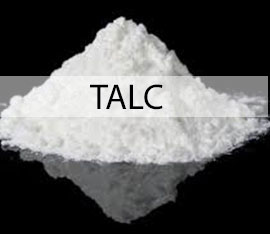
Talc is a naturally occurring mineral, The pure talc mineral is a hydrous magnesium silicate, Mg3Si3O10(OH)2, which theoretically is 31.7 percent MgO, 63.5 % SiO2, and 4.8 (H2O). Talc is considered to be the softest mineral existing on earth. This is because it has a value of 1 on the Mohs' hardness scale. due to that quite easy to cut & crush. This mineral exhibits the perfect cleavage in a single direction. This is the main reason as to why it breaks into nice thin sheets. Talc has a greasy feel when touched and this is the primary reason why it is utilized as a lubricant.
Application
Coating Pigments
Paper Industries
Plastics
Cosmetics
Rubber& Elastomers
Paints & Coatings
Talc in Plastics
The platy shape of talc particles can increase the stiffness of products such as polypropylene, vinyl, polyethylene, nylon, and polyester. It can also increase the heat resistance of these products and reduce shrinkage. Where the plastic is extruded in the manufacturing process, talc's very low hardness produces less abrasion on equipment than harder mineral fillers.
When used in plastics, the plates of talc make the resin more rigid and stronger. Polypropylene parts reinforced with as much as 40 percent of talc have replaced metal in many automotive applications, such as bumpers, interior plastic ductwork and fascias, as manufacturers have aimed to reduce weight, improve gasoline mileage, and reduce the number of separate parts that have to be made. Another usage in plastics is as an antiblock in blown polyethylene films. Without the use of an antiblock, it is difficult to pull the two faces of a plastic bag apart.
Talc in Ceramics
Mostly talc consumed was used in the manufacturing of ceramics products such as bathroom fixtures, ceramic tile, pottery, and dinnerware. . Ceramic wall tile contains up to 65 percent talc in the formulation.
When used as a filler in ceramics, talc can improve the firing characteristics of the greenware and the strength of the finished product along with better glaze shrinkage is non.
Talc in Paint & coating
Most paints are suspensions of mineral particles in a liquid. The liquid portion of the paint facilitates application, but after the liquid evaporates, the mineral particles remain on the wall.
Talc is used as an extender and filler in paints. The platy shape of talc particles improves the suspension of solids in the can and helps the liquid paint adhere to a wall without sagging.
Powdered talc is a very bright white color. This makes talc an excellent filler in paint because it simultaneously serves to whiten and brighten the paint
Talc improves exterior durability, controls viscosity, brushing, and gloss properties. It also reduces paint formulation costs, by extending or replacing more expensive resins and solvents.
Talc in Paper
Most papers are made from a pulp of organic fibers. This pulp is made from wood, rags, and other organic materials. Finely ground mineral matter is added to the pulp to serve as a filler. When the pulp is rolled into thin sheets, the mineral matter fills spaces between the pulp fibers, resulting in a paper with a much smoother writing surface. Talc as a mineral filler can improve the opacity, brightness, and whiteness of the paper. Talc also can also improve the paper's ability to absorb ink.
Talc in Cosmetics and Antiperspirants
Finely ground talc is used as the powder base of many cosmetic products. The tiny platelets of a talc powder readily adhere to the skin but can be washed off easily. Talc's softness allows it to be applied and removed without causing skin abrasion.